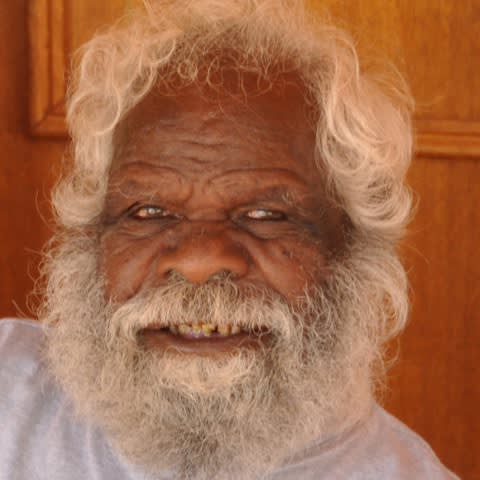Tommy Yannima Watson is a major Pitjantjatara artist, born in Anumarapiti, desert land west of the Irrunytju Community, also known as Wingellina, in Western Australia. Tommy Watson is a Law man of the Karima skin group, and his traditional names of Yannima and Pikarli relate to specific sites near his birthplace.
Tommy Watson’s parents and uncle died when he was young, so he was adopted by Nicodemus Watson, his father’s first cousin. The fate of Watson and his family, and many of the other western desert nomads was sealed with the introduction of assimilation policies. This combined with the severe drought throughout the 1950's resulted in many of the Pitjantjatjara, Ngaanyatjarra and Pintupi Aborigines moving from their home lands to the administrative centres in Warburton, Ernabella and Papunya. The unfamiliar world of the Government settlements was no place for these free nomadic people who were used to a life of unlimited travel. They became disoriented, most never adjusting. Tragically, more than half of the population of these new communities died. Eventually in the late 1970's and early 1980's most returned to their traditional homelands.
Tommy was settled at the Ernabella Mission, where he lived a bush life travelling through the Musgrave Ranges and Petersham Ranges, surrounding the mission. These wanderings embedded in him a deep knowledge of the country, both on a physical and spiritual level.
In his adult years Watson worked as a stockman and labourer on cattle stations around Uluru in the 1960s and 70s. Watson also travelled to other communities, including Hermannsburg where he witnessed Albert Namatjira - the trailblazer of contemporary Indigenous Australian art - paint his famous watercolours. Watson also travelled to the community of Papunya when the pioneers of the western desert art movement first set down their powerful expressions of their Tjukurrpa (Dreaming). So, whilst Tommy Watson did not begin to paint until his 60s, he was well aware of the Aboriginal art movement. In his mid 60s, Tommy Watson began painting at Irrunytju art centre with a small group of artists who set up there in 2001. He became quickly recognised for his powerful use of colour and energetic canvases, which were exhibited in Alice Springs at Desert Mob and in Darwin at the Telstra NATSIAA Art Awards. His work became highly collectable and his reputation continued to strengthen. In 2006 he was among eight Aboriginal artists whose work was integrated into the Quai Branly Museum in Paris.
Receiving critical acclaim, both across Australia and internationally, art critics have drawn parallels between Watson and Western Abstract painters such as Kandinsky, Mondrian and Rothko. Watson’s works feature in public and private collections worldwide.
Collections
Art Gallery of New South Wales
National Gallery of Australia
National Gallery of Victoria
Musée du Quai Branly, Paris
Art Gallery of Western Australia
South Australian Art Gallery
Museum and Art Gallery of the Northern Territory
